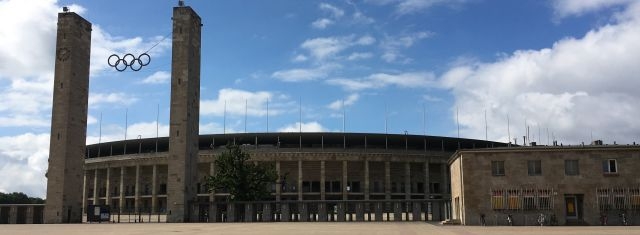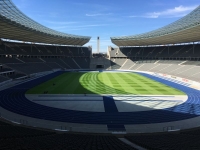Travel
Olympiastadion ““ Germania and Beyond
The largest stadium when it was built

Olympiastadion from the main entrance (Source: Jonathan Got)
USPA NEWS -
Remodelled for the 1936 Summer Olympics in Berlin by Hitler´s favorite architects Werner March (whose father, Otto March, designed the original 1913 stadium) and Albert Speer, the Olympiastadion was a symbol of power for the National Socialist party and an opportunity to present propaganda.
Being the westernmost structure on Hitler´s “˜capital city of the world´, the stadium was designed to present the then National Socialist Germany to the rest of the world as a power to be reckoned with. Any visitor to the stadium doesn´t only see the gigantic stadium, but also experiences the whole Olympic complex. Visitors would arrive at a 10-platform S-Bahn station able to serve at high frequencies for large events and then walk several hundred meters with a clear view of the huge imposing stone stadium as soon as visitors reached the car park.
Though some might argue that neither the U- nor S-Bahn stations named after the stadium provided convenient access to the sports grounds, one has to consider the scale of the event. The stadium could accommodate up to 100,000 people, so the immense scale of the plaza in front of the stadium and its car park serve as a buffer so hoards of visitors could arrive safely with plenty of space. The long walk also served the purpose of heightening expectations and creating a sense of suspense for incoming visitors then exceeding their expectations by presenting them with the largest stadium in the world.
Though a larger stadium for 400,000 people was planned for Nuremburg, March and Speer spared no expense when it came to decorating the stadium with Graeco-Roman themed ornaments. In the spirit of National Socialist neo-classicism, giant torches lit the colonnade from the inside and hooks and flagpoles were made available to hand wreaths and drape swastika flags all over the building. Nude statues of athletes that worship the pure form of the body in an ancient Greek manner adorn the open space and stairs leading up to the stadium. The grand entrance to the stadium alone commands fear and reverence.
Unlike most modern stadiums, the half underground and half above ground Olympiastadion has outdoor corridors running perpendicular to the colonnade. No shops, no service centers, no information counters, no nonsense. The facade created a sense of depth by not putting anything in the corridors; the stadium walls are obscured behind the colonnade and balcony-like corridors, fading into darkness even in the light of day. Visitors walking into the stadium feel as if German stone has engulfed them before being thrown into the bare, sunlit stadium.
Looking straight ahead, visitors can see thorough the gap in the stadium all the way to the bell tower that overlooks the Maifeld. It was clear that the stadium was going to be reused in the Thousand Year Reich for political rallies and demonstrations to boast the might of a National Socialist Germany after the Olympics. Between the gaps sits the Olympic Torch on a pedestal for the people of the world to see a flame lit by the sun in Greece and carried all the way over to Berlin by 3000 runners.
Coming to its functional aspects after the 1936 Summer Olympics, why didn´t the allied armies destroy this monument of evil as they did the Kanzleramt and the flak towers? Same as the answer to the Templehof Airport and buildings of government departments of the Third Reich ““ practicality. Being a large stadium in the middle of a sporting complex, the new occupiers of Berlin found more value in the stadium´s existence than its destruction.
Up until 1994, the British occupying forces also used the adjacent Maifeld for their annual celebration of the Queen´s Birthday, completing the stadium´s original purposes for political rallies in the most unexpected way. With a makeshift roof added for the 1974 FIFA World Cup group A matches and then a replacement steel and canvas roof added for the 2006 FIFA World Cup finals, the Olympiastadion in Berlin is still well-used. Since then it has also hosted the FIFA Womens World Cup, UEFA Champions League Final, as well as concerts for numerous well-known pop artists.
Fortunately for Europe, the war against fascism was won, but it meant that many of the structures of the Welthauptstadt remained uncompleted. The Olympiastadion is the largest of the completed original structures (along with the streetlights on the Straße des 17 Juni, the Air Ministry Building, and Fehrbelliner Platz just to name a few) showing how ambitious Hitler was to impose Germany as the new world superpower through ambitiously scaled architecture and grandiose urban planning.
Liability for this article lies with the author, who also holds the copyright. Editorial content from USPA may be quoted on other websites as long as the quote comprises no more than 5% of the entire text, is marked as such and the source is named (via hyperlink).






